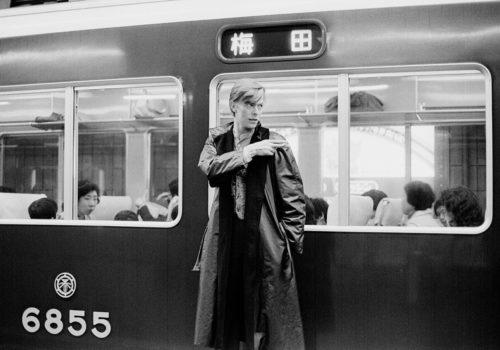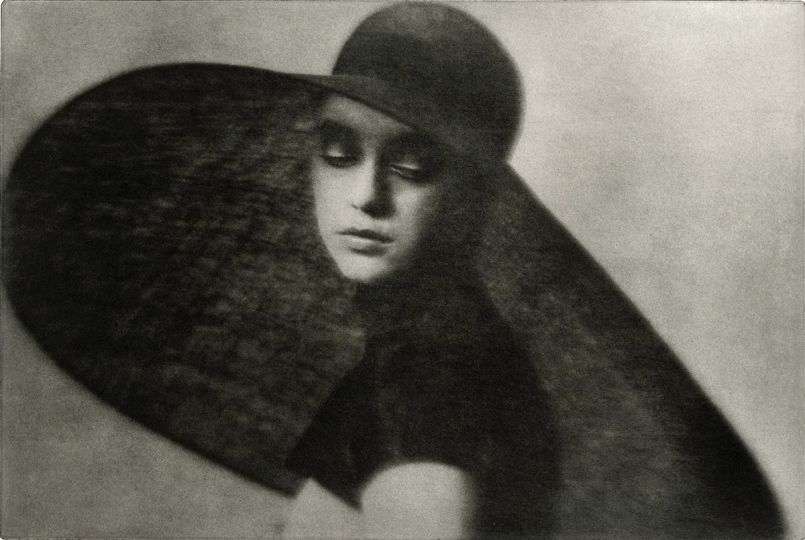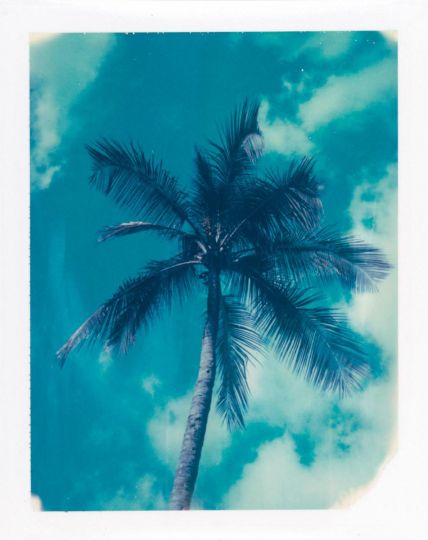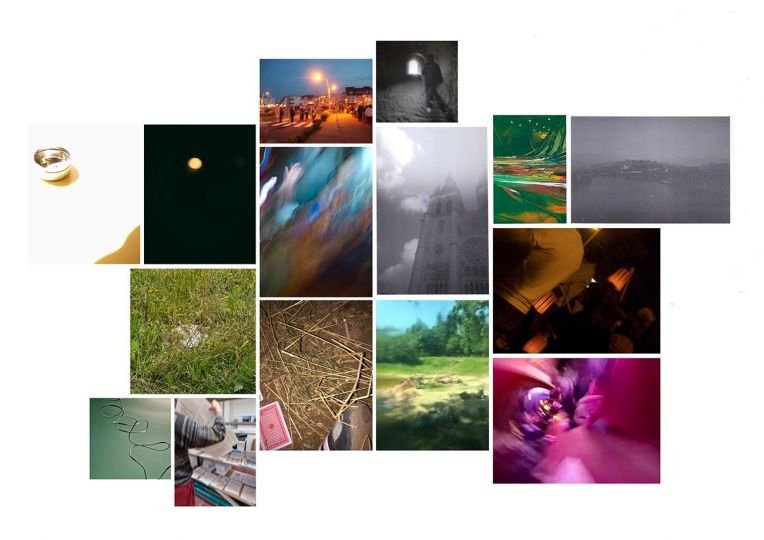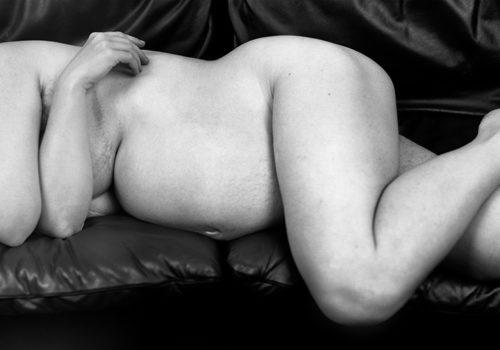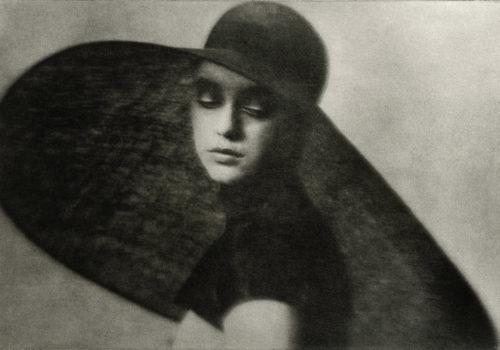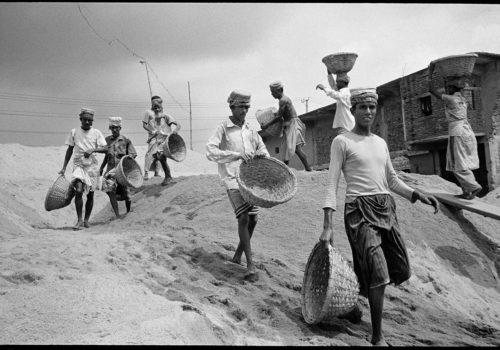It’s very hard for me to accept that Sukita-san has been snapping away at me since 1972, but that really is the case. I suspect that it’s because whenever he’s asked me to do a session, I conjure up in my mind’s eye the sweet, creative and big-hearted man who has always made these potentially tedious affairs so relaxed and painless. May he click into eternity. – David Bowie, 2011
The stars look very different today.
January 10, 2016 was such a grievous, particular date. It was the day when news guy wept and told us that David Bowie had passed.
“I believe in the premise of taking yourself to extremes, just to add a deeper cut to one’s personality,” Bowie told an almost famous Cameron Crowe (who still lived with his parents) in 1974. Anyone who forever lives in Bowie’s gorgeously articulate Art Decade, when he could hear tomorrow coming and just seemed to pour out this nimiety of supreme sounds and all these photogenic looks, knows precisely what s/he was doing on that tenth day of the new year and how each of us was trying to deal with the finality and the terrible blow of that message.
“Yes, I was in my bed and checked my email and watched the news which said that Bowie was dead,” says Maurizio Guidoni from Ono Arte Contemporanea in Bologna, who along with his gallery colleague Vittoria Mainoldi and Kulturhuset’s Swedish in-house curator Maria Patomella have produced the excellent Bowie by Sukita – From London to Japan exhibition in Stockholm. “I immediately sent an email to Sukita with my condolences. He responded after three days. He was completely out of words. He always thought that he would die before Bowie because there is a nine-year difference. Aki [the photographer’s nephew and manager] told me that Sukita didn’t want to talk to anyone.”
Sukita’s earliest commemoration appeared through an interview in the February issue of Metropolis, a free magazine for the English-speaking population in Japan: “David Bowie had an amazing aura in front of the camera. Since that first session in 72, I continued to capture him on several other occasions. But to be honest, I don’t think I really understood Bowie that first time. In 77, when I shot the photo for ‘Heroes’, I was desperate to capture his unique aura and his quick movements. My real memory of that day is watching him change his pose continuously and feeling like I had to keep taking as many photos as I could as not to lose the moment. After that day, I took a lot of other people’s portraits; but I never asked them to do this pose or that pose. I always try to capture the artist’s own movements and gestures by keenly observing their worldview. So I believe he changed the way I take photos of people.”
Masayoshi Sukita was born in a coalmining town on the southernmost of Japan’s main islands, the mountainous Kyushu, on May 5, 1938. His father was killed in China just after the end of WWII and the strongest memory that Sukita holds of him is through a photograph of the father bathing together with his brothers in arms. Sukita discovered the world of cinema through his good-natured uncle who assumed the role of a substitute father. Postwar Japan (which in fact was governed by the Allies of the WWII and led by a US administration until 1952) was in no way a place that suited Sukita – so the youngster would often get on his bike and pedal a hundred kilometres to get another fix of screen rebels, musicals, Americana and, in his own words, “visions”.
“American pop culture arrived overwhelmingly in Japan after the end of the Second World War,” Sukita told an interviewer. “I was extremely interested in American culture but I was also intrigued by what was happening in Europe. It was a fertile, productive time in the Western world and over in Japan we were trying to figure out the new styles and trends. I was undoubtedly influenced by pop culture and ever since I was young, I always wanted to take photos that would bear witness to what was happening in the world.”
Sukita was a would-be rebel and a full-out dreamer during his time at the Japan Institute of Photography and Film in Osaka as well. He often skipped the classes for self-studies in “French New Wave cinema and British films too. I felt that the best school lessons were from watching world cinema.” Sukita moved to Tokyo in 1965 and for a number of years he worked in the field of commercial advertising, which was soon also combined with art photography – this new turn in Sukita’s unfolding career transpired as he started to learn from a master in Osaka, Shisui Tanahashi.
You enter the Bowie by Sukita show at Kulturhuset (the House of Culture) in Stockholm through a wall painting of the graphic legs of the black bodysuit with the white stripes called “Tokyo Pop”, which is an original design by Kansai Yamamoto for David Bowie. The first print that meets the visitor is a solitary one from Sukita’s extravagant Watch That Man series (there are several more of these inside of course), with Bowie donning that very suit in front of a bright red backdrop like a Triadischer Ballett figure or some cat from Japan.
And this was Sukita’s second studio session with Bowie, who had requested Sukita for the assignment. It took place at RCA, Bowie’s record label during the 70s, in New York City in 1973 where Bowie was rehearsing with his band before the shows at Radio City Music Hall on February 14–15 (Yamamoto gifted him with five new outfits backstage) and a smaller second tour across the US. Bowie took himself and Ziggy Stardust to Japan for the first time (where there were nine more Yamamoto stage costumes waiting for him), arriving by sea in Yokohama in April – for here was a Starman who refused to fly until the early autumn of 1977 when Bowie just had to make it to Marc Bolan’s funeral.
There is a kind of backroom in the exhibition with a floor-standing lightboard of Sukita and Bowie from the first time that they met in 1972. This room has an elegant arrangement of ordinary blinds cleverly arranged like Japanese hand fans from the ceiling (and an unnecessary tabletop display case with a bland dose of printed matter), but most of all two walls of Sukita’s new and old works that are related only to himself as a quality artist with a set of cameras.
On one wall is a beautiful colour photo of a kimono-wearing woman whose profile face is concealed by a stylish conical hat that takes up one-third of the picture. On the other wall is an even more beautiful piece in black and white of the same composition; one is from 2018 and the other from 1957: “This is the first picture that he took in his life when his mother had given him a camera, his family was so poor but she understood how important that was to him,” says Guidoni. “Sukita told us that this picture of his mother in a summer kimono is still to this day his favourite. It is in the tradition of Japanese photography, and recently he took more or less the same picture, in the same room of the house, of his niece. The kimono is a little bit different but the rest is the same.”
A couple of the few Bowie pictures that do not work so well in the exhibition are from a 1980 photoshoot in Tokyo in which Bowie looks like a remodelled Monsieur Hulot, nine years after Trafic, trapped in the squirrel wheel of a clock that has only ten hours to offer. Bowie by Sukita is in and of itself a lovely, yet melancholy, attestation of the evanescence of time and of photography’s capacity to deal with this treasure in richer ways than to take another cigarette and put it in your mouth. This is also very much so an exhibition about trust.
“David Bowie was portrayed by many, many photographers, but we think that Sukita-san had a special eye for Bowie because they had a special relationship. This relationship lasted for forty years. Masayoshi Sukita couldn’t speak any English so it was mainly a silent relationship based on feelings, inspiration and common grounds,” explains Vittoria Mainoldi. “Another remarkable thing is that the only commission work that Sukita ever did with Bowie was in 1973, the one with the red background. Every other time, they found each other. It was a real friendship and the pictures were meant as two friends exchanging their points of view.”
Guidoni says that his discovery came via one of Sukita’s photobooks, “and I realised that there was something completely different compared to English and American photographers – there is no filter and there is a special atmosphere, something that I have never seen before in my life.” When asked how they got in touch, he says that it was a long process with a string of emails “and no reply. And then we wrote him a letter which we translated into Japanese – no reply. We tried again with a couple of emails, and then we received a reply because Sukita’s nephew realised that they could have exhibitions. Then we met him in Bologna. Sukita was so kind to us and we have done many museum shows in Europe. And books.”
One of these books is David Bowie by Sukita: Spectacular Photos of a Legend (with texts in English and German), which mustn’t be judged by its prosaic cover design since its contents are the opposite with the classic pictures and a rewarding take on the interview format: “People who buy the book write to let us know that this is a fantastic way to tell a story, by Sukita in first person. We had several Skype calls with him and a Japanese translator, several, about everything that we wanted to discuss. We put it together and sent the material to his nephew who translated it for Sukita to approve. I love this way and we try to do this kind of thing with other photographers because in most of the cases they have private access to people, so they are able to tell stories through photography and memories really well.”
According to Maurizio Guidoni, Sukita has never really been that much of a music person himself – “Sukita told me that he didn’t visit Woodstock [in 1969] for the music but because it was the place to be at the time” – and as a musicians’ photographer he has always primarily been into interesting characters and, above all, Bowie’s unique and intriguing persona. By the early 1970s, Sukita had secured sufficient means to live an itinerant life which was absolutely ideal for his wellbeing and for the development of his photography. Andy Warhol’s Factory, Broadway and other such landmarks were of course places of excitement, but it was in London that Sukita pieced it all together with the indispensable assistance of his stylist, translator and key to the artists, Yakko Takahashi.
After a four-hour long photoshoot with Marc Bolan on June 30, 1972, Sukita was strolling back to his hotel when a guy in a kicking rock pose on a street poster piqued his curiosity. The thirty-four-year-old photographer had never heard about this artist before, however much wisely bought a ticket to his concert at the Royal Festival Hall on July 8. Five days later Sukita got his first photoshoot in a borrowed studio with this effete (diamond) pup who had just released an album called The Rise and Fall of Ziggy Stardust and the Spiders from Mars.
In his book Blood and Glitter, Mick Rock calls Bowie’s alien intersexual rockstar “A dreamer of Dada with glitter in his soul.” Ziggy Stardust’s official photographer was only pleased to salute this colleague from Japan whose first images of Bowie happened when the artist had quite dropped his Lauren Bacall-goes-hippie look of Hunky Dory (Bowie’s first imperative album, released in December 1971) and was advancing towards this new creation – for here was a Starman waiting in the sky with a collection of outrageously great songs, flaming red hair and a living to go with the flamboyant image.
When Ziggy Stardust appeared for the world during three concerts at the Rainbow Theatre in August 1972, there was a blow-up print in the foyer from Sukita’s very recent photoshoot with Bowie. As a reflection, there is a black and white blow-up in Stockholm of the performer in a weird Burretti outfit backstage at this London venue. Bowie is smoking one of his sixty daily cigarettes – having the exit door to his back, which leads “Only to Street” – while he’s peering into some unknown distance, which effectively is in the direction of the stage. His future.
“It was no longer just a matter of music, there was so much more to him,” narrates the photographer in the David Bowie by Sukita publication. “Bowie had arrived on the scene and created a new world for himself which centred around a character from outer space and in that science fiction landscape he himself was the alien star – a new, wildly popular idol with an androgynous, otherworldly appearance. It was completely new, innovative, extraordinary and incredible; it had a profound effect on me.”
In the September 2012 issue of the Australian free magazine Trouble, Sukita told Inga Walton about his first impressions of Bowie: “I quickly realised that David Bowie wasn’t a regular performer. I felt that there was much more going on, so much more depth and imagination than from regular musicians. I understood entirely how he felt about using and playing with different media, how he was also inspired by cinema and combined other ideas with his own concepts to create something bold and new. David-san was expressing many of the interests I also felt and could relate to, ideas that I was trying to show in my own work.”
What does it say about the Boring Twenties that two of the worst films made in this young decade are supposed to be about David Bowie – the ridiculous insult Stardust (2020) and the Gen Z-toadying futility of hypertension, Moonage Daydream (2022)? David Bowie Is was the name of a comprehensive show that opened at the V&A in 2013. The curators persevered with the title’s present tense, and for a good reason, during the two last years when Bowie had left us and the show was still travelling. Masayoshi Sukita’s discernment for everything that David Bowie is – and this must be stressed with pleasure – is pronounced and embodied in these portraits of his friend as they appear at Kulturhuset in Stockholm.
“Around this time, David was beginning to be even more of a nocturnal creature,” Bowie’s childhood friend Geoff MacCormack recalls in his photographic memoir David Bowie: Rock ‘n’ Roll with Me. He toured and travelled with Bowie and also lived with him and his everlasting personal aide Coco Schwab in Los Angeles during the year when the star’s frail health, misery and exercises in sorcery due to an uncontrolled consumption of pharmaceutical cocaine excelled his creative faculty. “Coco and I would try to create some kind of order by occasionally cooking breakfast and getting David up before noon. But one was loath to wake somebody who’d been awake for three days straight. On a good day, Coco and I would knock on David’s bedroom door with a glass of juice and a mug of tea and proclaim, ‘My Lord, William of Orange and the Earl of Grey to see you,’ and he would reply, ‘Enter.’ Then I would hang out with him for a while, watching a film or some TV – the children’s program Mister Rogers’ Neighbourhood was a show which eternally fascinated us. That’s how it was. On a good day.”
When Bowie’s third masterpiece Diamond Dogs was out in May 1974, he was already living in New York and soaking up the city’s Hispanic culture forms and the black music that was played at the Apollo. Bowie’s disintegration into coke hell was more than obvious in Cracked Actor (1975), Alan Yentob’s fantastic BBC documentary in which he follows a snivelling, paranoid and yet still utterly creative and fascinating David Bowie for a couple of weeks during his North American Diamond Dogs Tour in the autumn of 1974, when he looked like the living dead that he sings of on that album.
Bowie was down to forty kilos when he appeared at the Grammy Awards in the spring of 1975 and the British music weekly Record Mirror reported on his scrawny state of health: “His physical deterioration was sad to behold. His corpselike appearance only made more grotesque by a severe 50s-style haircut and ill-fitting suit. His voice too was in appalling shape and it was almost pitiful to watch him aiming hoarsely at notes he could once reach with ease.” In all this, Bowie relocated to LA, a place he later referred to as “the most vile pisspot in the world”.
During his two years of living and surviving in America, Bowie (since this is David Bowie) recorded his soul-y Young Americans album (released in March 1975), divinely played the humanoid alien (“My one snapshot memory of that film is not having to act. Just me being as I was perfectly adequate for the role. I wasn’t of this Earth at that particular time”) in Nic Roeg’s rare beauty The Man Who Fell to Earth (1976), recorded Station to Station (January 1976), rid himself of the inadequate Mainman organisation and its pack of revellers and, by his own efforts, tacked together a new band in Jamaica for the Isolar – 1976 Tour and the return of the Thin White Duke.
That Europe was closest to Bowie’s heart was evident as he opened the shows with music by Kraftwerk and a screening of the Buñuel–Dalí surrealist short film Un chien andalou (1929). Early on during the forty-date stretch of the North American part of the tour, David Hockney was backstage with Christopher Isherwood whose novels about his time in Weimar Berlin had captivated Bowie – who was an avid reader of all sorts of books – to the point that the writer had to tell him that much of the stories were just figments of imagination (“Young Bowie, people forget that I’m a very good fiction writer”) and that he should similarly realise that the Babylon Berlin of the early-30s was gone for good.
“Ever since his brother Terry had introduced him to bebop jazz and Jack Kerouac, Bowie was in awe of fearless exponents of improvisational writing and performance. Iggy Pop was their modern counterpart and in him Bowie saw his own future. The sessions at Oz [Studios in Hollywood] pointed the way to a new spontaneous working method. For now, he just had to keep Iggy upright long enough to get something down to tape,” argues Roger Griffin in his day-by-day treatise about Bowie’s 1970s, The Golden Years.
On March 26, 1976, Bowie boarded a ship to Cannes for the European leg of the tour (twenty-five more shows) together with Coco, a new awareness about Berlin and some momentous ideas on his mind: “[German Expressionism] was an artform that mirrored life not by event but by mood. This was where I felt my work was going. My attention had been swung back to Europe with the release of Kraftwerk’s Autobahn in 1974. The preponderance of electronic instruments convinced me that this was an area that I had to investigate a little further.”
David Bowie lived at Hauptstrasse 155 in Berlin between October 1976 and February 1978, with Iggy Pop as his playmate. “He arrived in Berlin without his personas and costumes to hide behind and create alien worlds. At almost thirty he was a mature man, ready to go to the next level, not only with his music but in his life as well,” remarks Masayoshi Sukita in David Bowie by Sukita. “‘Heroes’ has always been a very important album for me, not just because of my photo as the album cover but for its search for new sounds and new languages of expression that it has in its foundation. Doing this kind of research in the shadow of the Berlin Wall, just a few steps from the border between two worlds was so innovative that it marked an era.”
Bowie devised a lot of the major ideas for his album (and, on most days, his finest achievement) Low from working on Iggy Pop’s first solo album at Château d’Hérouville in the summer of 1976 – “I thought he was the funniest, darkest lyricist of the time,” Bowie stated many years later. “The Idiot, for me, was a new kind of musical scenario” – and both of these classics were mainly recorded at the Honky Château northwest of Paris. When the work with Low was over, Bowie had to grapple with RCA since the label did not understand it, nor did they find it worthy of a release and was delaying it until January 1977. His next album, “Heroes” (the only record that Bowie actually made in Berlin) was recorded between July and August at Hansa Tonstudio, one hundred and fifty metres from the Wall, and was out in October that same year. And what a year.
Berlin to Bowie was “the antithesis of Los Angeles” and the locals allowed him to live a comparatively regular life in so far as the Berliners minded their own sorrows. “I like to go out and get lost and be in places made of wood, just to wash every shred of America off. Taking a walk was like taking a shower,” he admitted. The Dum Dum Boys discovered Berlin together on bicycle and by foot, went to galleries and art museums (the Brücke Museum was a favourite), watched German art films and the current golden age of New Hollywood cinema, frequented bars and danced at nightclubs where the drinking was beyond all reason.
Since Bowie had a fondness for all kinds of detours, there were many crossings made to the other side of the Wall in his dented black Mercedes-Benz 600 Landaulet limousine (the factual vehicle on the Low track “Always Crashing in the Same Car”) through Checkpoint Charlie. Iggy’s girl in Berlin, Esther Friedman, had a diplomat father who cleared the path for them – adventures done for the great art of being alive and to experience out-of-the-ordinary enjoyments such as the theatre performances at Bertolt Brecht’s Berliner Ensemble. All this for (in today’s money) fourteen euros a day, which was what Coco allowed them to share.
“Bowie and Iggy Pop in Berlin is the most incredible story in popular culture in my opinion,” says Maurizio Guidoni. The name on the door to the seven-room apartment on the first floor to the left in this rather cheap Art Deco building on Berlin’s Hauptstrasse was Jones, Bowie’s actual cognomen. All the rooms were wood panelled and Bowie’s room with the open fire place was the finest, decorated with old paintings, Tiffany lamps, exquisite tapestry and handmade carpeting. Iggy Pop moved to another flat in the building after a while, but constant residents were Coco and Bowie’s five-year-old boy Zowie/Joey (today Duncan Jones) who shared a room with his beloved nanny Marion Skene. Bowie had an atelier for his painting, another room worked as his home studio. Every Thursday eve everyone gathered in front of the TV in a space surrounded by photo murals of the Swiss Alps to relish the 70s cop series Starsky and Hutch.
The rehearsals before The Idiot Tour took place in an old film studio in Berlin. Bowie followed Iggy on tour as his sidekick – Bowie as the unannounced, chain-smoking keyboard player and back-up vocalist, and he was loving every minute of it – through the UK and North America from the first of March till April 16. When they arrived in Tokyo to promote their albums in late April, Sukita was of course in attendance at the press conference and was granted a between-friends natured photoshoot with both Bowie and Iggy Pop, which was swiftly arranged in a borrowed studio in Harajuku the day before they travelled back to Berlin. Bowie’s only requirement was that the photos had to be straightforward black and white portraits, and that Sukita’s stylist and translator Yakko would provide him with a couple of black leather jackets.
“Bowie certainly did not want to be portrayed for his handsome face; he was looking for something else. At a certain point, in fact, he began to muss up his hair and assume expressions of pain and suffering. I had never experienced that in a shoot and it hasn’t happened since; public figures always want to look good in front of the camera,” Sukita reasons in David Bowie by Sukita. “For a photographer like me, capturing Bowie in the ‘Heroes’ period was extraordinary. All I had to do in the Tokyo studio was go along with what was a real and true performance coming from him.”
“Heroes” was conceived at Hansa after Bowie had finished the work with Iggy Pop’s new album in the same old Gestapo dancehall. Producer Tony Visconti deployed three microphones with the last one fifteen metres away to achieve the complete sound for Bowie’s vocals on the title track. They worked with Bowie’s musical director Carlos Alomar on rhythm guitar, Dennis Davis on drums and George Murray on bass – the best of the best. Robert Fripp was given a first-class ticket to cross the Atlantic to put his fantastic guitar work, all in one night and all first takes in real time, on six tracks that he wasn’t allowed to listen to before the takes. Bowie encouraged him to “play with total abandonment”.
“Berlin has the strange ability to make you write only the important things,” Bowie pondered. Not only had he originated a classic recording that summer, there was also this perfect photograph ready for the album cover. It is something of an honour and a luxury to face twenty of his best shots (and two contact sheets) at Kulturhuset from these sixty minutes that Sukita got with Bowie who, seated at a small table, began to model himself according to the same principle that he employed when he soon recorded “Heroes” with “absolutely no idea of the consequences, and no perceptions of any kind”. “Heroes” is a piece of art and Sukita’s image is part and parcel of what makes it so tremendously special.
“I learnt from the session how important it was to make my brain blank and believe in my own senses,” Sukita expressed in an interview. The truth of the matter was of course that he was enthralled by what was taking place before his camera eye, with Bowie doing everything but putting up a front or a character. Bowie, in beige corduroys and the black leather jacket that we see on the cover, fondling the other jackets in a fashion that looks like a bit of posing. Then he sits down at the table – and this is where it’s happening: Bowie turns his whole essence inside out, making himself known as a figure in an Expressionist painting with the show-it-all veneer of a jellyfish (as in a portrait by Egon Schiele), and then the emphasis on the hands. It is fascinating to see his course towards the picture that was chosen (in the almost-there shot, Bowie’s angular left hand is stuck in his hair), and it was the clear favourite for both of them.
That everything with “Heroes” was a success did not safeguard Sukita from humiliation, and the chagrin was threefold. To begin with it was the tactlessness of RCA which regarded these pictures as their property. When they demanded the photographer to hand over everything from this legendary photoshoot, to do as they pleased with his work, Bowie had to step in to tell his record company to shut up and show some manners. Then it was the album itself which RCA “forgot” to send him and the first time Sukita saw it was through the window of a record shop in Japan.
“How much did that single shot add to the mystique of the songs? Enough that it now seems fated. Enough that it caused The Next Day thirty-six years later,” argues Matteo Torcinovich in Outside the Lines: Lost Photographs of Punk and New Wave’s Most Iconic Albums. Bowie’s next-to-last album The Next Day (2013) used the “Heroes” album cover without Sukita’s approval, and designer Jonathan Barnbrook simply just crossed out the title of the original and put a white square on Bowie’s face with the new title inside. The white square reappears on the back as well and you can get what is left of the credits from “Heroes”: “raph Sukita”.
You do feel the ignominy behind the words in David Bowie by Sukita when the author of that photograph talks about the “large white square that seemed almost to censor the photo from 1977. The importance that the image still had for him was evident, even after so many years […] I was of course very impressed by the finished product and the idea behind it.” Maurizio Guidoni responds to Sukita’s strained courtesy by saying that “He is Japanese. But in the documentary Sukita – The Shoot Must Go On [2018], he meets the graphic designer in London and Jonathan Barnbrook apologises for not asking permission to use the image. Consider that they were thinking of using other Bowie sleeve designs but finally chose to use ‘Heroes’ – that is a great honour” – and then the co-curator pauses – “in a sense.”
Bowie abandoned his Berlin home (believe it or not but this historic place is a dental office today) at the beginning of 1978 when he went to Dallas to rehearse with the musicians for the seventy-eight-show-long Isolar II – The 1978 World Tour which lasted from March 29 to December 12. This tour was the best thing that he ever did as a stage performer, and with a backing band that was just out of this world. (At the day of the press preview in Stockholm, a Sukita print from that last show in Tokyo – with the linear fluorescent lamps behind a very stylish Bowie in a Jean Genet-pleasing stage outfit – was supported by the highly inaccurate time stamp of 1983, the year that Bowie put on the red shoes and completely lost it.
His cover of Jacques Brel’s “Amsterdam” was luckily deleted as the track that was meant to end side one of Ziggy Stardust. The same applies to “Crystal Japan” that was intended to be the closing track on one of Bowie’s finest albums, and his last masterpiece, Scary Monsters (September 1980). This so-so instrumental track would however lead him to Japan once again in late March 1980 for a TV commercial for shōchū (a very Nipponese libation) and another great photoshoot with Sukita, whose suggestion was to “shoot photos in ‘loco’ places, instead of so-called Japanese places as temples or shrines”.
This is savvy Bowie on a rainy day in Kyoto – Bowie on the metro, Bowie in a phonebooth, Bowie buying stuff at the old market, Bowie with an umbrella outside the Tawaraya Inn. “He had rented a car and asked me to sit in the back and photograph him,” Sukita reveals in David Bowie by Sukita. “Despite being a great star, Bowie did not live a life divorced from reality and everyday activities. In fact, when he left the car and started our journey on the metro, it was he who went to the ticket window and paid.” On a couple of gridwall panels in the exhibition, there are quite some smaller prints of Bowie buying these tickets and dancing all night long in the basement of his ryokan, of Iggy doing his The Idiot pose in Tokyo and other rock ‘n’ roll related shots like the one with Jim Jarmusch and Joe Strummer from the summer of 1988 when Sukita made his way to the set of Mystery Train.
Questioned why so few of these wonderful Kyoto pictures are shown at Kulturhuset, Guidoni discloses that “I think most of the people want to see the Ziggy Stardust and ‘Heroes’ series – but I think that it is more interesting to see the Kyoto series and we would like to have another book with more pictures from Kyoto. Sukita always asked Bowie for permission to show new pictures, and in most cases Bowie said yes. I believe that Sukita wants to keep some of the Kyoto pictures private because it was probably the most interesting shooting with Bowie.”
In all this Sukita galore, there are some lesser interesting things in Stockholm and they all have to do with 80s Bowie and Tin Machine Bowie (Sukita took the cover photo for the band’s first album in 1989). 80s Bowie was severely marked by the murder of his friend John Lennon on December 8, 1980. Bowie was playing John Merrick in The Elephant Man in New York at the time and struggled to carry out next evening’s performance. There were three empty front-row seats that night at the Booth Theatre on Broadway: one for Lennon, one for Yoko Ono and one for the killer. Bowie revealed in 2010 that he was next on the list.
Just back in London after holidaying with his son, Bowie appeared in a fine interview on ITV’s Afternoon Plus in February 1979. One of Marvis Nicholson’s questions was if he felt a bit like the alien protagonist that he portrayed in The Man Who Fell to Earth, a man (as she called it) “in his own void”? “Thematically I’ve always dealt with isolation in everything I’ve written, I think,” Bowie said with great attention to his host. “It’s that peculiar part of the human mind that fascinates me – about the small universes that can be created inside the mind, some of them fairly schizophrenic and quite off the wall.”
Bowie by Sukita is a one damn song.
Bowie by Sukita – From London to Japan at Kulturhuset in Stockholm, January 27–September 3, 2023.

